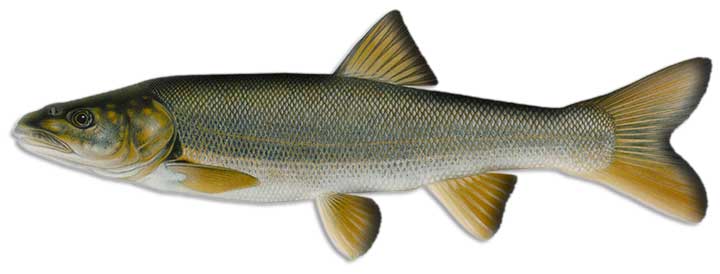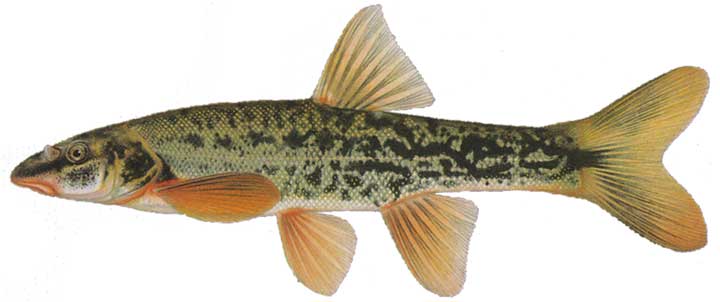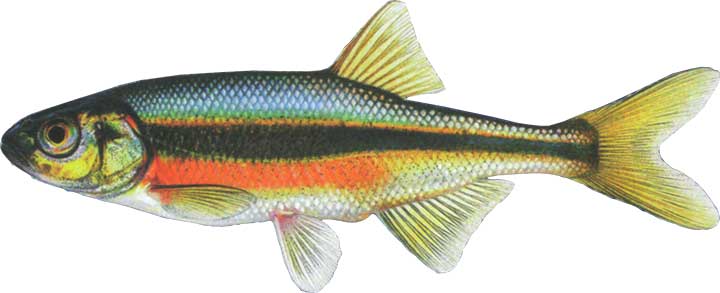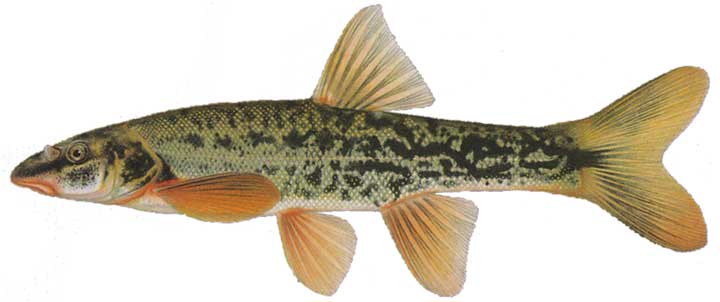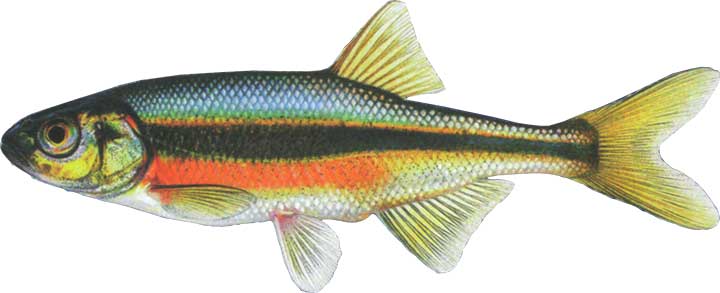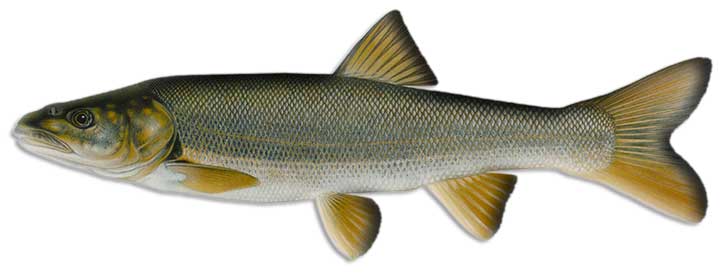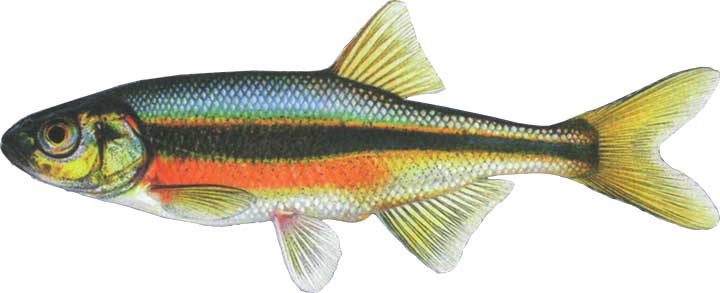Northern pikeminnows are members of the cyprinidae or minnow family. They are a member of the Ptychocheilus genus. That genus consists of three other species, all, including the northern pikeminnow, are native to western North America.
Minnows
Many people use the term "minnow" to refer to any small fish. But in science, minnow refers to a family of fish, and not all are small. Northern pikeminnows, for example, can grow up to 27 inches long in large rivers.
- Northern Pikeminnow Profile
- Identifying Northern Pikeminnow
- Species that Look Similar to Northern Pikeminnow
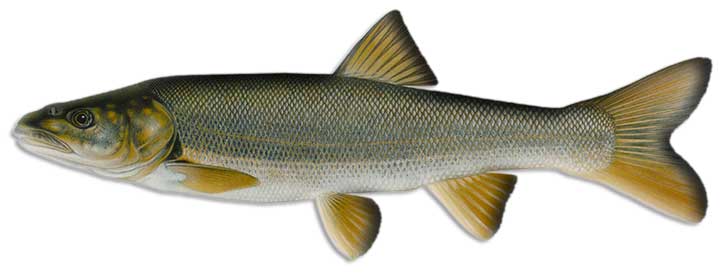
Click on a topic to learn more
- Other Names
Salish Name
The Salish call northern pikeminnow Qʷoʔqʷé
Scientific Name
Ptychocheilus oregonensis
Common Names
Pikeminnow, Columbia River dace. - Classification
- Average Size
The typical northern pikeminnow is about 12 inches, although they can get up to 27 inches. Most in the Jocko River are 12 inches or under.
- Life History
Females reach sexual maturity at about six years, males in three to five years (they can live longer than 15 years). Northern pikeminnow spawn from May to early July over gravelly areas in streams or lakes when water temperatures reach 55 to 65 degrees F. A mature female can lay 30,000 eggs annually.
- Diet
Northern pikeminnows are voracious predators. They eat most kinds of aquatic invertebrates, and adults frequently eat small fish (in the Columbia system, the Bonneville Power Administration has placed a bounty (reward) on them in order to reduce predation on scarce salmon stocks). In Montana, northern pikeminnow are considered a serious predator on young trout.
- Habitat
Northern pikeminnow prefer lakes and slow-flowing streams of moderate size. The young usually school in shallow water near lake shores and in quiet backwaters of streams.
- Status
Northern Pikeminnow populations have flourished with the development of the Columbia River Hydropower System. The reservoirs have provided excellent habitat for pikeminnow and given them an advantage over depressed native salmonid populations.
- Other Facts
In Montana northern pikeminnow are considered a nuisance species by some fisheries management agencies in parts of their range because they compete with trout for food and are predators of young trout.
Northern pikeminnow lack teeth, but are still effective predators.
Rollover a letter to learn how to identify a Northern Pikeminnow
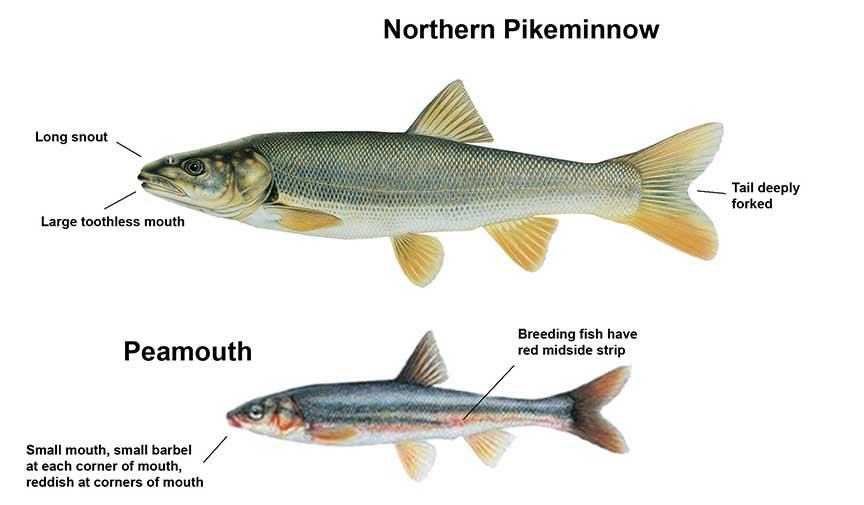

Click on a topic to learn more
- Other Names
Scientific Name
Rhinichthys cataractae
Common Names
The only common name is longnose dace. - Classification
Longnose dace are members of the Rhinichthys genus, which encompasses the riffle daces. Rhinichthys species, of which there are eight, range throughout North America.
- Average Size
The typical longnose dace is about 3 inches long. They can reach 6 inches in length.
- Life History
Longnose dace probably become sexually mature in 3 years. They spawn in late spring or early summer at 53° F in shallow riffle areas over gravel beds.
- Diet
Longnose dace eat mostly immature aquatic insects picked off the rocks. They also consume small amounts of algae and a few fish eggs.
- Habitat
The longnose dace has the most widespread distribution of all fish in Montana. It is found throughout all three of the major drainages. It is very adaptable, inhabiting almost every conceivable habitat: muddy and warm, clear and cold, streams and lakes. They are well-adapted for living on the bottom of fast-flowing streams among the stones.
- Status
Longnose dace populations appear to be doing well.
- Other Facts
Longnose dace are probably one of the most important forage minnows for larger predatory game fish.
Rollover a letter to learn how to identify a Longnose Dace


Click on a topic to learn more
- Other Names
Scientific Name
Richardsonius balteatus
Common Names
Red-sided bream, Columbia River minnow. - Classification
The redside shiner is a member of the minnow family. Its genus, Richardsonius, includes two species native to western North America.
- Average Size
The largest redside shiners are about 7 inches long, though the species averages about four inches.
- Life History
Redside shiners become sexually mature in 2 to 3 years. They usually spawn from June to July but they may spawn as early as May and as late as August. They spawn in schools.
- Diet
Young feed mainly on plankton. Adults eat mostly aquatic insects and snails.
- Habitat
Redside shiners live in lakes, ponds, and streams where the current is weak or lacking.
- Status
Redside shiners are doing well.
- Other Facts
The redside shiner is considered a nuisance species by fisheries management agencies in some areas and may become a competitor for food and space with trout species. This is not true of the Jocko River.
Rollover a letter to learn how to identify a Redside Shiner
Minnows
Many people use the term "minnow" to refer to any small fish. But in science, minnow refers to a family of fish, and not all are small. Northern pikeminnows, for example, can grow up to 27 inches long in large rivers.
- Northern Pikeminnow Profile
- Identifying Northern Pikeminnow
- Species that Look Similar to Northern Pikeminnow
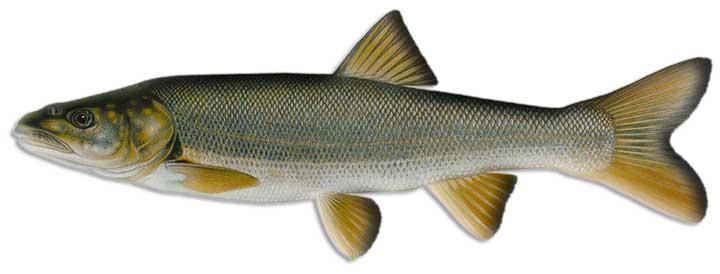
Click on a topic to learn more
- Other Names
Salish Name
The Salish call northern pikeminnow Qʷoʔqʷé
Scientific Name
Ptychocheilus oregonensis
Common Names
Pikeminnow, Columbia River dace. - Classification
Northern pikeminnows are members of the cyprinidae or minnow family. They are a member of the Ptychocheilus genus. That genus consists of three other species, all, including the northern pikeminnow, are native to western North America.
- Average Size
The typical northern pikeminnow is about 12 inches, although they can get up to 27 inches. Most in the Jocko River are 12 inches or under.
- Life History
Females reach sexual maturity at about six years, males in three to five years (they can live longer than 15 years). Northern pikeminnow spawn from May to early July over gravelly areas in streams or lakes when water temperatures reach 55 to 65 degrees F. A mature female can lay 30,000 eggs annually.
- Diet
Northern pikeminnows are voracious predators. They eat most kinds of aquatic invertebrates, and adults frequently eat small fish (in the Columbia system, the Bonneville Power Administration has placed a bounty (reward) on them in order to reduce predation on scarce salmon stocks). In Montana, northern pikeminnow are considered a serious predator on young trout.
- Habitat
Northern pikeminnow prefer lakes and slow-flowing streams of moderate size. The young usually school in shallow water near lake shores and in quiet backwaters of streams.
- Status
Northern Pikeminnow populations have flourished with the development of the Columbia River Hydropower System. The reservoirs have provided excellent habitat for pikeminnow and given them an advantage over depressed native salmonid populations.
- Other Facts
In Montana northern pikeminnow are considered a nuisance species by some fisheries management agencies in parts of their range because they compete with trout for food and are predators of young trout.
Northern pikeminnow lack teeth, but are still effective predators.
Rollover a letter to learn how to identify a Northern Pikeminnow
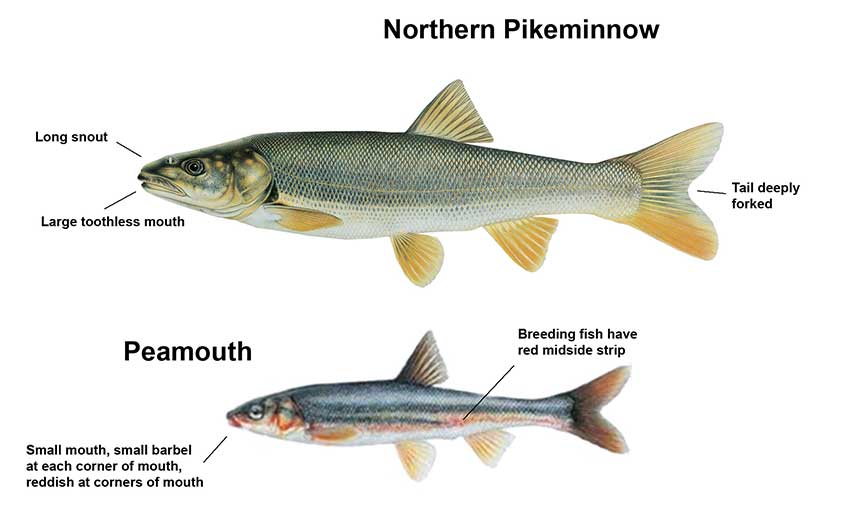
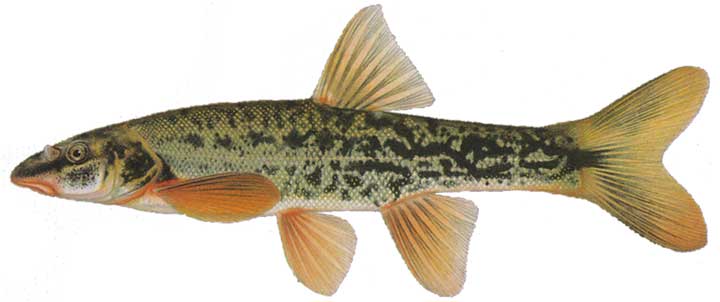
Click on a topic to learn more
- Other Names
Scientific Name
Rhinichthys cataractae
Common Names
The only common name is longnose dace. - Classification
Longnose dace are members of the Rhinichthys genus, which encompasses the riffle daces. Rhinichthys species, of which there are eight, range throughout North America.
- Average Size
The typical longnose dace is about 3 inches long. They can reach 6 inches in length.
- Life History
Longnose dace probably become sexually mature in 3 years. They spawn in late spring or early summer at 53° F in shallow riffle areas over gravel beds.
- Diet
Longnose dace eat mostly immature aquatic insects picked off the rocks. They also consume small amounts of algae and a few fish eggs.
- Habitat
The longnose dace has the most widespread distribution of all fish in Montana. It is found throughout all three of the major drainages. It is very adaptable, inhabiting almost every conceivable habitat: muddy and warm, clear and cold, streams and lakes. They are well-adapted for living on the bottom of fast-flowing streams among the stones.
- Status
Longnose dace populations appear to be doing well.
- Other Facts
Longnose dace are probably one of the most important forage minnows for larger predatory game fish.
Rollover a letter to learn how to identify a Longnose Dace
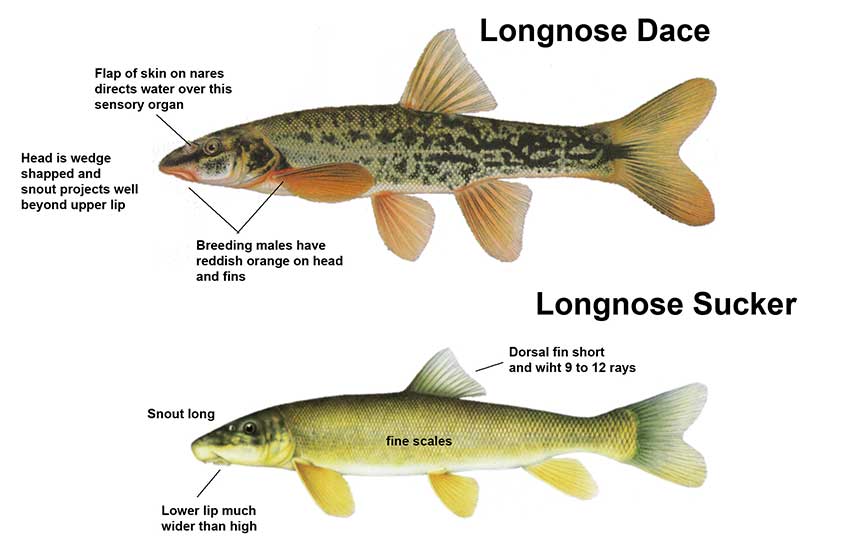
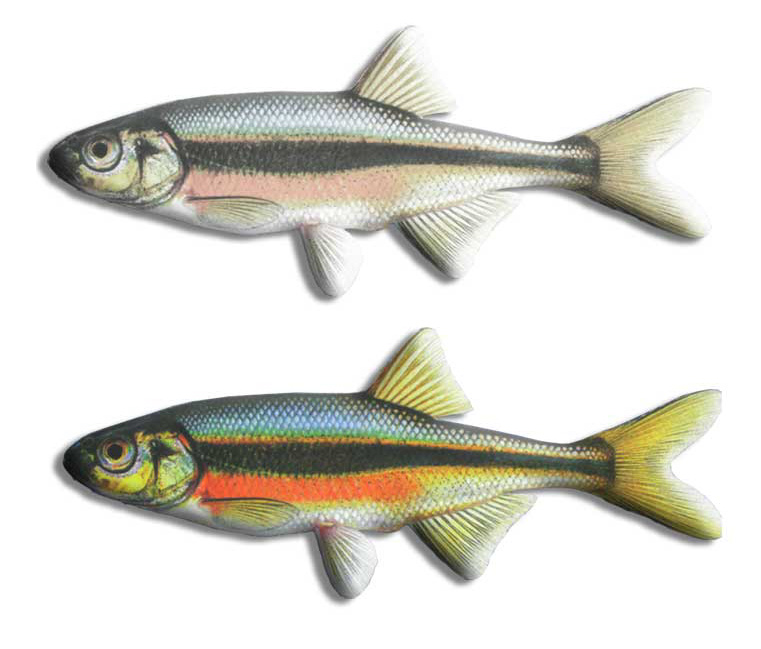
Click on a topic to learn more
- Other Names
Scientific Name
Richardsonius balteatus
Common Names
Red-sided bream, Columbia River minnow. - Classification
The redside shiner is a member of the minnow family. Its genus, Richardsonius, includes two species native to western North America.
- Average Size
The largest redside shiners are about 7 inches long, though the species averages about four inches.
- Life History
Redside shiners become sexually mature in 2 to 3 years. They usually spawn from June to July but they may spawn as early as May and as late as August. They spawn in schools.
- Diet
Young feed mainly on plankton. Adults eat mostly aquatic insects and snails.
- Habitat
Redside shiners live in lakes, ponds, and streams where the current is weak or lacking.
- Status
Redside shiners are doing well.
- Other Facts
The redside shiner is considered a nuisance species by fisheries management agencies in some areas and may become a competitor for food and space with trout species. This is not true of the Jocko River.
Rollover a letter to learn how to identify a Redside Shiner
Minnows
Many people use the term "minnow" to refer to any small fish. But in science, minnow refers to a family of fish, and not all are small. Northern pikeminnows, for example, can grow up to 27 inches long in large rivers.
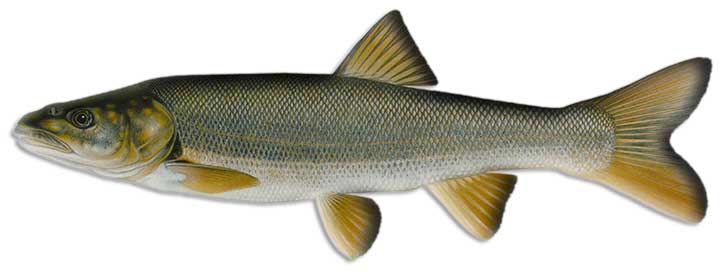
Click on a topic to learn more
- Other Names
Salish Name
The Salish call northern pikeminnow Qʷoʔqʷé
Scientific Name
Ptychocheilus oregonensis
Common Names
Pikeminnow, Columbia River dace. - Classification
Northern pikeminnows are members of the cyprinidae or minnow family. They are a member of the Ptychocheilus genus. That genus consists of three other species, all, including the northern pikeminnow, are native to western North America.
- Average Size
The typical northern pikeminnow is about 12 inches, although they can get up to 27 inches. Most in the Jocko River are 12 inches or under.
- Life History
Females reach sexual maturity at about six years, males in three to five years (they can live longer than 15 years). Northern pikeminnow spawn from May to early July over gravelly areas in streams or lakes when water temperatures reach 55 to 65 degrees F. A mature female can lay 30,000 eggs annually.
- Diet
Northern pikeminnows are voracious predators. They eat most kinds of aquatic invertebrates, and adults frequently eat small fish (in the Columbia system, the Bonneville Power Administration has placed a bounty (reward) on them in order to reduce predation on scarce salmon stocks). In Montana, northern pikeminnow are considered a serious predator on young trout.
- Habitat
Northern pikeminnow prefer lakes and slow-flowing streams of moderate size. The young usually school in shallow water near lake shores and in quiet backwaters of streams.
- Status
Northern Pikeminnow populations have flourished with the development of the Columbia River Hydropower System. The reservoirs have provided excellent habitat for pikeminnow and given them an advantage over depressed native salmonid populations.
- Other Facts
In Montana northern pikeminnow are considered a nuisance species by some fisheries management agencies in parts of their range because they compete with trout for food and are predators of young trout.
Northern pikeminnow lack teeth, but are still effective predators.
Rollover a letter to learn how to identify a Northern Pikeminnow
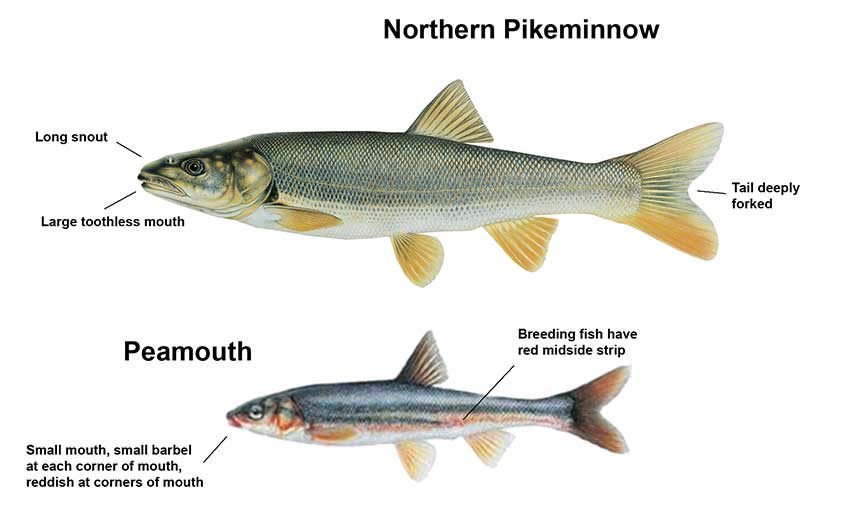

Click on a topic to learn more
- Other Names
Scientific Name
Rhinichthys cataractae
Common Names
The only common name is longnose dace. - Classification
Longnose dace are members of the Rhinichthys genus, which encompasses the riffle daces. Rhinichthys species, of which there are eight, range throughout North America.
- Average Size
The typical longnose dace is about 3 inches long. They can reach 6 inches in length.
- Life History
Longnose dace probably become sexually mature in 3 years. They spawn in late spring or early summer at 53° F in shallow riffle areas over gravel beds.
- Diet
Longnose dace eat mostly immature aquatic insects picked off the rocks. They also consume small amounts of algae and a few fish eggs.
- Habitat
The longnose dace has the most widespread distribution of all fish in Montana. It is found throughout all three of the major drainages. It is very adaptable, inhabiting almost every conceivable habitat: muddy and warm, clear and cold, streams and lakes. They are well-adapted for living on the bottom of fast-flowing streams among the stones.
- Status
Longnose dace populations appear to be doing well.
- Other Facts
Longnose dace are probably one of the most important forage minnows for larger predatory game fish.
Rollover a letter to learn how to identify a Longnose Dace
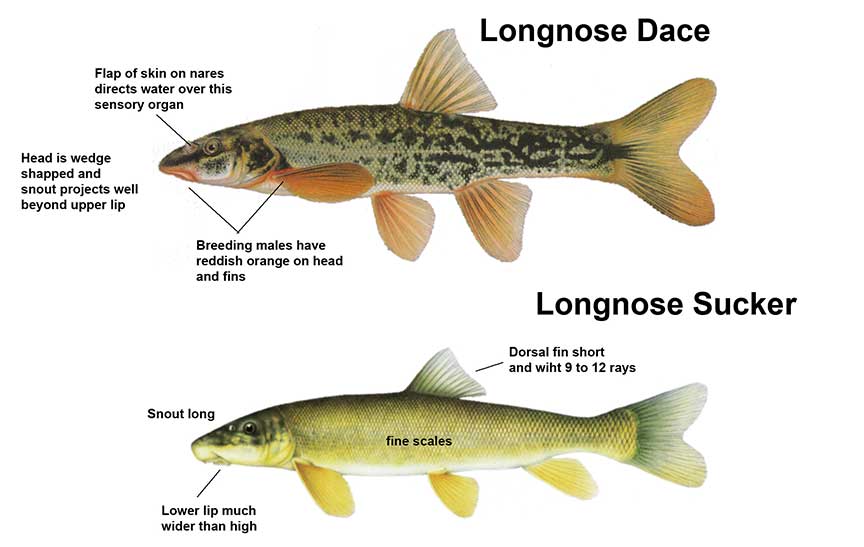
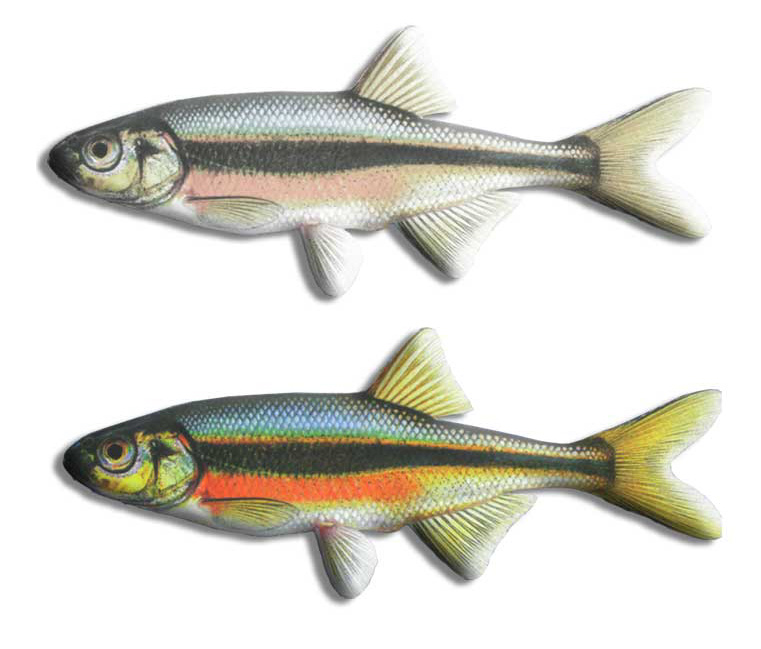
Click on a topic to learn more
- Other Names
Scientific Name
Richardsonius balteatus
Common Names
Red-sided bream, Columbia River minnow. - Classification
The redside shiner is a member of the minnow family. Its genus, Richardsonius, includes two species native to western North America.
- Average Size
The largest redside shiners are about 7 inches long, though the species averages about four inches.
- Life History
Redside shiners become sexually mature in 2 to 3 years. They usually spawn from June to July but they may spawn as early as May and as late as August. They spawn in schools.
- Diet
Young feed mainly on plankton. Adults eat mostly aquatic insects and snails.
- Habitat
Redside shiners live in lakes, ponds, and streams where the current is weak or lacking.
- Status
Redside shiners are doing well.
- Other Facts
The redside shiner is considered a nuisance species by fisheries management agencies in some areas and may become a competitor for food and space with trout species. This is not true of the Jocko River.
Rollover a letter to learn more
© 2021 Confederated Salish and Kootenai Tribes | Contact Us
© 2021 Confederated Salish and Kootenai Tribes | Contact Us
